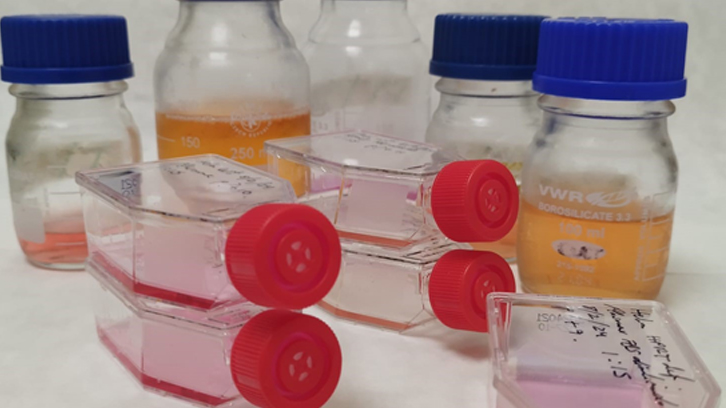Cell culture medium conditions are key for the study of Lesch-Nyhan's disease

Ludwing Feuerbach, a German philosopher and anthropologist, said in the 19th century: "If you want to improve the people, instead of speeches against sins, give them better food. Man is what he eats". Today we know that excess or deficiency of nutrients in the diet produces disease. So why do researchers keep the cells they study in an environment with an excess of nutrients? Aren't they drawing the wrong conclusions from their experiments?
The research group coordinated by Dr. Jose Manuel López Blanco, at the UAB Institut de Neurociències, has been investigating Lesch-Nyhan disease for some time. It is a hereditary disease, in which a protein involved in the metabolism of purines does not work properly. In less severe cases, an accumulation of uric acid is observed which can be treated with allopurinol. But in severe cases, very acute neurological symptoms are also observed, including self-injurious behaviors, and greatly reducing the patients' life expectancy. Unfortunately, to date, there is still no treatment for these neurological effects.
To study the disease in the laboratory, our research group receives samples of fibroblasts (skin cells) from patients, coming from Emory University (Atlanta). We grow them in plates and analyze them using different molecular biology techniques. However, the first few times we did it, we were surprised to see that the cultured cells did not reproduce the problems we expected. The fibroblasts of Lesch-Nyhan patients did not accumulate one of the key intermediates of the purine metabolic pathway, unlike the patients, who did accumulate this metabolite in the blood, or one of its derivatives in the urine. In other words, in this aspect, the fibroblasts of the patients behaved like the control cells.
To understand what was happening, we must consider that when cells are grown in plates, we add them a culture medium: a cocktail of nutrients that feed them, so they can grow and reproduce. In most commercial culture media, the components are not found in the concentrations of our body but are over-represented, to ensure the correct growth of the cells. This can lead to imprecise conclusions, as conditions are not representative of what happens in reality.
This problem has begun to be considered in recent years, and research groups are already working with culture media that contain most nutrients in the same concentrations as the plasma. However, vitamins are still over-represented in this medium. Vitamins, despite not being plasma major components, are involved in the cells metabolic pathways, so they play a crucial role in their functioning. Our research group already showed in a previous article, published in 2020 in the journal PNAS, the importance of folic acid concentrations, a crucial vitamin in the purine’s synthesis, for the study of Lesch-Nyhan.
Now, in a publication in the journal Molecular Medicine, we describe what we consider to be the optimal cell culture conditions for the study of this disease with fibroblasts: the culture medium Plasmax-PV (Plasmax-Physiological Vitamins), where we add the necessary vitamins to mimic the amounts of plasma. Using this medium, we have seen that fibroblasts from Lesch-Nyhan patients have changes in their mitochondria (their membrane potential is decreased), there is an increase in the amount of folate transporters, and we see difficulties in migration, among others problems We could not observe all these alterations when folic acid was in high concentrations in the culture medium, suggesting that supplements with folic acid could be a possible therapy for this disease.
We consider that our study is not only an advance to better understand Lesch-Nyhan disease, but also a good example to reflect that the cell culture conditions have to be optimal to not mask what is really happening.
Institut de Neurociències (INc) and Departament of Biochemisty and Molecular Biology
Universitat Autònoma de Barcelona
References
Escudero-Ferruz P, Ontiveros N, Cano-Estrada C, Sutcliffe DJ, Jinnah HA, Torres RJ, López JM. A new physiological medium uncovers biochemical and cellular alterations in Lesch-Nyhan disease fibroblasts. Mol Med. 2024 Jan 3;30(1):3. Doi: 10.1186/s10020-023-00774-8. PMID: 38172668; PMCID: PMC10765874.
López JM, Outtrim EL, Fu R, Sutcliffe DJ, Torres RJ, Jinnah HA. Physiological levels of folic acid reveal purine alterations in Lesch-Nyhan disease. Proc Natl Acad Sci U S A. 2020 Jun 2;117(22):12071-12079. Doi: 10.1073/pnas.2003475117. Epub 2020 May 19. PMID: 32430324; PMCID: PMC7275668.


